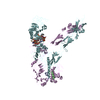+Search query
-Structure paper
| Title | Functional selectivity of insulin receptor revealed by aptamer-trapped receptor structures. |
|---|---|
| Journal, issue, pages | Nat Commun, Vol. 13, Issue 1, Page 6500, Year 2022 |
| Publish date | Oct 30, 2022 |
 Authors Authors | Junhong Kim / Na-Oh Yunn / Mangeun Park / Jihan Kim / Seongeun Park / Yoojoong Kim / Jeongeun Noh / Sung Ho Ryu / Yunje Cho /  |
| PubMed Abstract | Activation of insulin receptor (IR) initiates a cascade of conformational changes and autophosphorylation events. Herein, we determined three structures of IR trapped by aptamers using cryo-electron ...Activation of insulin receptor (IR) initiates a cascade of conformational changes and autophosphorylation events. Herein, we determined three structures of IR trapped by aptamers using cryo-electron microscopy. The A62 agonist aptamer selectively activates metabolic signaling. In the absence of insulin, the two A62 aptamer agonists of IR adopt an insulin-accessible arrowhead conformation by mimicking site-1/site-2' insulin coordination. Insulin binding at one site triggers conformational changes in one protomer, but this movement is blocked in the other protomer by A62 at the opposite site. A62 binding captures two unique conformations of IR with a similar stalk arrangement, which underlie Tyr1150 mono-phosphorylation (m-pY1150) and selective activation for metabolic signaling. The A43 aptamer, a positive allosteric modulator, binds at the opposite side of the insulin-binding module, and stabilizes the single insulin-bound IR structure that brings two FnIII-3 regions into closer proximity for full activation. Our results suggest that spatial proximity of the two FnIII-3 ends is important for m-pY1150, but multi-phosphorylation of IR requires additional conformational rearrangement of intracellular domains mediated by coordination between extracellular and transmembrane domains. |
 External links External links |  Nat Commun / Nat Commun /  PubMed:36310231 / PubMed:36310231 /  PubMed Central PubMed Central |
| Methods | EM (single particle) |
| Resolution | 3.6 - 4.27 Å |
| Structure data | EMDB-34018, PDB-7yq3: EMDB-34019, PDB-7yq4: EMDB-34020, PDB-7yq5: EMDB-34021, PDB-7yq6: EMDB-34281, PDB-8guy: |
| Source |
|
 Keywords Keywords | STRUCTURAL PROTEIN / receptor-ligand complex / receptor-ligand complex_B_local / receptor-ligand complex_B_overall / receptor-ligand complex_C |
 Movie
Movie Controller
Controller Structure viewers
Structure viewers About Yorodumi Papers
About Yorodumi Papers













 homo sapiens (human)
homo sapiens (human)